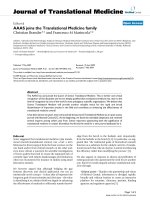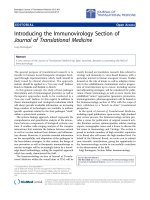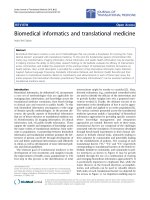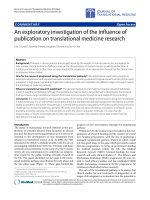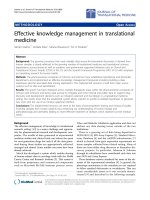Báo cáo hóa học: " Translational Medicine - doing it backwards" ppt
Bạn đang xem bản rút gọn của tài liệu. Xem và tải ngay bản đầy đủ của tài liệu tại đây (179.64 KB, 3 trang )
EDI T O R I A L Open Access
Translational Medicine - doing it backwards
Robert B Nussenblatt
1*
, Francesco M Marincola
2
, Alan N Schechter
3
Abstract
In recent years the concept of “translational medicine” has been advanced in an attempt to catalyze the medical
applications of basic biomedical research. However, there has been little discussion about the readiness of scien-
tists themselves to respond to what we believe is a required new approach to scientific discovery if this new con-
cept is to bear fruit. The prese nt paradigm of hypothesis-driven research poorly suits the needs of biomedical
research unless efforts are spent in identifying clinically relevant hypotheses. The dominant funding system favors
hypotheses born from model systems and not humans, bypassing the Baconian principle of relevant observations
and experimentation before hypotheses. Here, we argue that that this attitude has born two unfortunate results:
lack of sufficient rigor in selecting hypotheses relevant to human disease and limitations of most clinical studies to
certain outcome parameters rather than expanding knowledge of human pathophysiology; an illogical approach to
translational medicine. If we wish to remain true to our responsibility and duty of performing research relevant to
human disease, we must begin to think about fundamental new approaches.
NIH is the nation’s medical research agency - making important medical discoveries that improve health and save
lives.
NIH is the steward of medical and behavioral resear ch for the Nation. Its mission is science in pursuit of fundamental
knowledge about the nature and behavior of living systems and the application of that knowledge to extend healthy
life and reduce the burdens of illness and disability [1].
Editorial
A recent candidate for a post-doctoral fellowship posi-
tion came to the laboratory for an interview and spoke
of the wish to leave in vitro work and enter into mean-
ingful in vivo work. He spoke of an in vitro observation
with mouse cells and said that it could be readily
applied to treating human disease. Indeed his present
mentor had told him that was the rationale for doing
the studies. When asked if he knew whether the
mechanisms he outlined in the mouse existed in
humans, he said that he was u naware of such i nforma-
tion and upon reflection wasn’ t sure in any event how
his appr oach could be used with patients. This is a sce-
nario that is repeated again and again in the halls of
great institutions dedicated to medical research. Any self
respecting investigator (and those they mentor) k nows
that one of the most important new key words today is
“translational”. However, in reality this clarion call for
medical research, often termed “Bench to Bedside” is far
more often ignored than followed. Indeed the paucity o f
real translational work can make one argue that we are
not meeting our coll ective responsibility as stewards of
advancing the health of the public. We see this failure
in all areas of biomedical research, but as a community
we do not wish to acknowledge it, perhaps in part
because the system, as it is, supports superb science.
Looking this from another perspective, Young et al [2]
suggest that the peer-review of journal articles is one
subtle way this concept is perpetuated. Their article sug-
gests that the incentive structure built around impact
and citations favo rs reiteration of popular work, i.e.,
more and more detailed mouse experiments, and that it
can be difficult and dangerous for a career to move into
a new arena, especially when human study is expensive
of time and money
However, pharmaceutical compa nies do bemoan the
drying up of the therapeutic and diagnostic pipeline and
theoftenirrelevanceofin vitro and animal models to
human disease. This has led to the marked diminution
in the last several decades of the intro duction of funda-
mental new agents into clinical medicine, despite the
* Correspondence:
1
Laboratory of Immunology, National Eye Institute, National Institutes of
Health, Bethesda, MD 20892, USA
Nussenblatt et al. Journal of Translational Medicine 2010, 8:12
/>© 2010 Nussenblatt et al; licensee BioMed Central Ltd. This is an Open Access article distributed under the terms of the C reative
Commons Attribution License ( enses/by/2.0), which permits unrestricted use, distribution, and
reproduction in any medium, provided the original work is properly cited.
immense expenditures for biomedical research Indeed, it
can be very readily argued that we understand the nor-
mal and abnormal states of mice more than we do
human [3], and often what is known in both can be
very different [4]. As Steinman wrote recently, “ Animal
models actually sometimes give results that are the
opposite of what is ultimately seen in human disease.”
[5] We see such examples in recent clinical studies. A
double -masked, randomized, placebo-controlled, test-of-
concept trial studying the efficacy of an anti-HIV-1 vac-
cine aimed at eliciting cell-mediated immunity (Step
Study) failed at the interim analysis after 741 vaccine
and 762 placebo recipients had been treated; the vaccine
did not alter the incidence o f infection and infection
rates tended to be higher in some treatment cohorts [6].
Unfortunately, no quality collections of human samples
were included in the study to learn from this failure.
This is just one of a myriad number of examples that
populate the medical literature. In the case of HIV,
these types of challenges have led many to call for a glo-
bal vaccine enterprise, where clinical trials are better
integrated with the basic science [7].
Most (with few recent potential exceptions) rando-
mized cancer vaccine trials demonstrated poor efficacy
and in some cases wors e outcome in vaccinated patients
[8,9]. The conclusion was t hat “vaccines do not work”
[8], in spite of their ability to elicit cellular and immune
responses which is their biological end-point. A better
statement would be that vaccines do work since they
reach their biological goal but we have no knowledge of
the requirements in human pathophysiology that allow
antigen-specific T or B cells to exert their effector func-
tion [10-12]. Such information is missing in humans
simply because trials fail to study the immune response
where it is most relevant: the tumor site. Thus, basic
questions could not be answered: did vaccine-induced T
cells reach the tumor site? Was the tumor expressing
the antigen targeted by the vaccine? Why some tumors
respond and some did n ot? We will never know unless
tumor biopsies will be obtained at the right time in the
course of treatment [10]. Most scientists and clinicians
involved in anti-cancer immunotherapy do agree in the-
ory that this should be done but like Sisyphus they per-
petuate the enigma by following the easier path of
testing the peripheral circulation or in animal models,
looking over and over for the lost keys where the light
is rather than where the keys were lost.
What is needed is a different template to return to the
focus of our attention, the normal human state and the
diseased. As Davis [3] recently noted while animal mod-
els are successful tools for understanding basic immu-
nology they have not been successful as models of
human disease. He very rightly advocates a new
approach towards strategically directed efforts in human
immunology. This can only mean to abandon the mis-
named “Bench to Bedside” approac h for a truly iterative
approach with constant interplay of clinical, laboratory
and even epidemiological studies. What is needed is an
approach that begins at the Bedside and then goes to
the “ Clinical Bench” (associated studies done with
patients), and finally to the animal or cellular model. It
is incongruous to rely upon the use of cell or animal
models if we don’ t know what the human pathways are.
It is remarkable that a community that prides itself on
facts, data, and rational thinking cannot come to address
and recognize this very uncomfortable truth. At a time
that genomic and other molecular approaches allow us
to ask very sophisticated que stions about normal and
pathological processes in human beings our increasing
reliance upon systems regarded as “models” for p eople
makes no sense. A good example of observations that
seem to have gone in the correct direction is that of th e
autoimmune lymphoproliferative syndrome (ALPS) [13].
Here the disorder, including its clinical and immunolo-
gic characteristics as well as its genetic defect, was
defined in humans. This paved the way for later labora-
tory studies, including animal models that had relevance.
Research on model systems can bring fundamental
new biological insights and animals are necessary for
much work in drug development. Further, when systems
in humans and animals are proven to be very similar,
animal research can be very valuable in the first steps of
testing new hypotheses. But such work is only part of
the new conceptualization of biomedical research so
urgently needed.
It has been a few years since we suggested, in the open-
ing editorial of the Journal of Translational Medicine,
that translational medicine is a two-way road with the
bedside-to-bench direction playing a Cinderella-like role
[14]. We proposed that attention to clinical realities
should play a primary role in framing scientific questions
according to human reality. We suggested, later on [15],
that a significant impediment to the progress of biomedi-
cal research is the lack of appreciation by the current
scientific establishment for descriptive, evidence-search-
ing studies (sometimes called “ omics”) upon which to
begin a rethinking of much biomedical research. Rather,
our system is locked into testing poorly conceived
hypotheses thus bypassing one of the basic elements of
the scientific revolution, the Baconian principle of rele-
vant observation and experimentation, i.e. in humans.
We argued that the scientific c ommunity, while profi-
ciently settling on the third, has p rogressively forgotten
the first two. This has born two unfortunate results:
1) Lack of sufficient rigor in selecting h ypotheses
relevant to human disease to be tested in the labora-
tory or even later in in clinical studies.
Nussenblatt et al. Journal of Translational Medicine 2010, 8:12
/>Page 2 of 3
2) Lack of sufficient rigor in conceptualizing clinical
studies aimed not only at validation of t herapies but
also of learning from all results so as to better design
subsequent trials.
Thus, we propose that hypothesis tested research
should follow “facts-driven research” and only when the
collection of facts relevant to human disease has been
extensive, should hypotheses be constructed to expand
beyond what can be directly observed.
Many naysayers will quickly come to the defense of
the present system, pointing t o some important
advances of the last two decades. The issue is rather
how efficient is our approach in meeting the NIH’sgoal
of making import ant medical discoveries that improve
health and save lives with its current resource base.
Indeed, it can be argued that a large fraction of impor-
tant observations in medicine st emmed from the clinic
and laboratory work elucidating abnormal pathways.
One recent example is that of t rinucleotide repeats and
the association with neurologic disease [16]. This semi-
nal o bservation led to much fundamental research.
Another was the elucidation of prions in human disease
[17]. This corpus has led to enormous activity i n this
domain, including subsequent model s tudies even in
yeast.
This is perhaps the crux of the need and what will be
threatening to some. Clinically active physicians and
non-physicians who are trained to understand human
disease processes need to take a far more pro-active role
in determining the paths of discovery. Today’ s training
of physician-scientists still remains weak, in spite of
efforts by the NIH and others in conceptualizing these
needs. In part this is because they are being trained for
niches that barely exist in many medical centers. Train-
ing based upo n applications, as in engineering, would
repre sent a significan t paradigm shift for the biomedical
community as a whole. However, in many ways it would
be a return to the concept outlined by Stokes, where the
best science in each discipline is done in the (Pasteur’s)
quadrant of scientific approaches most applicable, as lar-
gely the case in years past [18]. Indeed the new Director
of the NIH has enunciated the need to have a stronger
focus on clinical research as an important way to justify
the NIH budget [19]. I f we wish to remain true to our
self-enunciated goals, we must begin to think about new
approaches to effecting translational research.
Author details
1
Laboratory of Immunology, National Eye Institute, National Institutes of
Health, Bethesda, MD 20892, USA.
2
Infectious Disease and Immunogenetics
Section (IDIS), Clinical Center and Trans-NIH, Center for Human Immunology
(CHI), National Institutes of Health, Bethesda, MD, 20892, USA.
3
Molecular
Medicine Branch, National Institute of Diabetes, Digestive and Kidney
Diseases, National Institutes of Health, Bethesda, MD, 20892, USA.
Received: 29 January 2010
Accepted: 8 February 2010 Published: 8 February 2010
References
1. The NIH mission. 2009http://www nih gov/about/index html#mission.
2. Young NS, Ioannidis JP, Al-Ubaydli O: Why current publication practices
may distort science. PLoS Med 2008, 5:e201.
3. Davis MM: A prescription for human immunology. Immunity 2008,
29:835-838.
4. Mestas J, Hughes CC: Of mice and not men: differences between mouse
and human immunology. J Immunol 2004, 172:2731-2738.
5. Steinman L: Mixed results with modulation of TH-17 cells in human
autoimmune diseases. Nat Immunol 2010, 11:41-44.
6. Buchbinder SP, Mehrotra DV, Duerr A, Fitzgerald DW, Mogg R, Li D,
Gilbert PB, Lama JR, Marmor M, Del RC, et al: Efficacy assessment of a cell-
mediated immunity HIV-1 vaccine (the Step Study): a double-blind,
randomised, placebo-controlled, test-of-concept trial. Lancet 2008,
372:1881-1893.
7. Klausner RD, Fauci AS, Corey L, Nabel GJ, Gayle H, Berkley S, Haynes BF,
Baltimore D, Collins C, Douglas RG, et al: Medicine. The need for a global
HIV vaccine enterprise. Science 2003, 300:2036-2039.
8. Rosenberg SA, Yang JC, Restifo NP: Cancer immunotherapy: moving
beyond current vaccines. Nat Med 2004, 10 :909-915.
9. Goldman B, DeFrancesco L: The cancer vaccine roller coaster. Nat
Biotechnol 2009, 27:129-139.
10. Wang E, Panelli MC, Marincola FM: Gene profiling of immune responses
against tumors. Curr Opin Immunol 2005, 17:423-427.
11. Wang E, Selleri S, Sabatino M, Monaco A, Pos Z, Stroncek DF, Marincola FM:
Spontaneous and tumor-induced cancer rejection in humans. Exp Opin
Biol Ther 2008, 8:337-349.
12. Wang E, Albini A, Stroncek DF, Marincola FM: New take on comparative
immunology; relevance to immunotherapy. Immunotherapy 2009,
1:355-366.
13. Rao VK, Straus SE: Causes and consequences of the autoimmune
lymphoproliferative syndrome. Hematology 2006, 11:15-23.
14. Marincola FM: Translational medicine: a two way road. J Transl Med 2003,
1:1.
15. Marincola FM: In support of descriptive studies: relevance to translational
research.
J Transl Med 2007, 5:21.
16. Brouwer JR, Willemsen R, Oostra BA: Microsatellite repeat instability and
neurological disease. Bioessays 2009, 31:71-83.
17. Michalczyk K, Ziman M: Current concepts in human prion protein (Prp)
misfolding, Prnp gene polymorphisms and their contribution to
Creutzfeldt-Jakob Disease (CJD). Histol Histopathol 2007, 22:1149-1159.
18. Stokes DE: Pasteur’s quadrant: basic science and technological innovation The
Brookings Institution 1997.
19. Fox M: In tough economic times, NIH head looks to clinic. 2010http://
www reuters com/article/healthNews/idUSTRE60O40J20100125.
doi:10.1186/1479-5876-8-12
Cite this article as: Nussenblatt et al.: Translational Medicine - doing it
backwards. Journal of Translational Medicine 2010 8 :12.
Submit your next manuscript to BioMed Central
and take full advantage of:
• Convenient online submission
• Thorough peer review
• No space constraints or color figure charges
• Immediate publication on acceptance
• Inclusion in PubMed, CAS, Scopus and Google Scholar
• Research which is freely available for redistribution
Submit your manuscript at
www.biomedcentral.com/submit
Nussenblatt et al. Journal of Translational Medicine 2010, 8:12
/>Page 3 of 3
